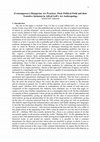Papers by Gabriella Szigethy
Published in: Filozófus a műteremben. Tanulmányok Radnóti Sándor 70. születésnapjára, ELTE Eötvös... more Published in: Filozófus a műteremben. Tanulmányok Radnóti Sándor 70. születésnapjára, ELTE Eötvös Kiadó, Budapest, 2016.
Published in: Emlékkerti kőoroszlán. Írások György Péter 60. születésnapjára, Eötvös Loránd Tudom... more Published in: Emlékkerti kőoroszlán. Írások György Péter 60. születésnapjára, Eötvös Loránd Tudományegyetem, Bölcsészettudományi Kar, Budapest, 2014.
Drafts by Gabriella Szigethy

1. Introduction My aim in this paper is twofold. First, I'd like to re-read Alfred Gell's Art and... more 1. Introduction My aim in this paper is twofold. First, I'd like to re-read Alfred Gell's Art and Agency nearly twenty years after it was first published and see how his idea of a radical re-positioning of objects in " art-like situations " can be used in politically informed interferences in a place never exactly defined in Gell's work, Eastern-Europe which is neither East, nor West in his binary view. Gell's essentially homogeneous understanding of the Western art canon does not calculate with the specificities of art production on the peripheries of this canon where similar institutions of art exist with very different histories, impacts and ways of usage however. Why I think so or how I can prove this is probably part of this first endeavour. Secondly, since my academic background is that of art history and aesthetics I am especially interested in how what we mean by Western art production or ideologies informing this specific branch of objects can be explained without aesthetics. In my understanding aesthetics has been an unalienable part of this production since the end of the 18th century. Gell's view is evident in this respect: evaluative, prescriptive, meaning-oriented ideologies are hardly of anthropological interest. Quite understandably the postcolonial discourse unfolding in the years before and after Gell's book has been effectively casting away aesthetics as an elitist, white privilege on ethical grounds and as such has apparently been the love-child of Gell's anthropology. Here I'd like to argue for a more nuanced view: Jacques Ranciere and more recently Claire Bishop have been reclaiming aesthetics by rephrasing the socio-political ambience of its origins and history. Maybe in that light Gell's abduction of agency can still be explained in a meaningful way? Maybe aesthetics is capable of encountering the other without the exploitation of the other after all? In the last couple of years all components of what we call the institution of art have been questioned and requestioned, challenged and contested, endlessly. This has been a period of grave disunity and increasing restlessness. By " the institution of art " I mean a conglomerate in fact, the artist, the actual art object, the viewer, the place where art is stored, ie. the museum and art criticism in general, too. To add to all this apparent " freeze and liquefy, […] freeze and liquefy again " (Sholette 2016) situation in contemporary art the content of each and every component of this conglomerate has endlessly been redefined, too, so from that angle we cannot even be sure whether contemporary art is a meaningful entity at all. By the redefinition of contents of these components I mean giving up authorship for the sake of participation and distributed responsibility, giving up objecthood for the sake of process-based events and interventions, giving up spectatorship for the sake of the equal partner or collaborator, giving up the idea of a museum inherited from the 19th century and going out with art production into hitherto unprivileged and unframed places and spaces and finally adopting new languages to describe this production altogether. Hans Belting, one of the few remaining representatives of a grand school of art history-who however hammered the first nail into the very coffin of this grand school at the beginning of the 1980's when he asked if it was the end of art history after all-, (Belting 1983) has recently declared that " There is no common notion of art that necessarily applies to all societies around the world. " (Belting 2012: 16) By admitting this he seems to have had admitted defeat in a battle having been fought about one of the most crucial historical issues in and around art, namely, whether it is possible to find a common denominator for objects and activities whose aims are manifold: to please, to shock, to awe or maybe to teach or to freak out or to engage their viewers in a devotional manner or otherwise. Belting's main concern in this essay is this common denominator: he argues that for this to be born the West has to give up its obsession with history, the East its obsession with ethnicity so
My talk at the A találkozások antropológiája - The Anthropology of Encounters. Frictions of the P... more My talk at the A találkozások antropológiája - The Anthropology of Encounters. Frictions of the Past, Present and Future. Conference of the Hungarian Cultural Anthropological Association (HCAA). 4-5 November, 2016. Szeged, Hungary.
A tér kolonializációja Egy olyan emlékműről, köztéri szoborról, utcai tereptárgyról szeretnék bes... more A tér kolonializációja Egy olyan emlékműről, köztéri szoborról, utcai tereptárgyról szeretnék beszámolni, mely, sejtésem szerint, még azok számára sem túl ismert, akik érdeklődnek az előbbiek iránt. Ez alatt a magyarországi holokauszt és/vagy munkaszolgálatos emlékműveket értem általában illetve a mai Magyarországon a legváratlanabb helyeken és időpontokban előtüremkedő köztéri szobrokat. 1 Mivel a megidézendő tereptárgy elhelyezésének ötlete, kivitelezése és felavatása a létező legnagyobb csendben történt, leginkább azok tudhatnak róla, akik, mint én is, a közelben laknak és akiknek olyan kedves barátaik vannak, akik régóta elmélyült figyelemmel követik és kommentálják a nyolcadik kerületi önkormányzat különböző bizottságainak áldásos tevékenységét. Hozzászólásom tehát nem jöhetett volna létre civil kontroll és állampolgári öntudat nélkül. 2
A part of my doctoral dissertation, presented originally at a conference in Budapest, in 2008.
The extended English version of Tetthely (published in Hungarian).











Uploads
Papers by Gabriella Szigethy
Drafts by Gabriella Szigethy